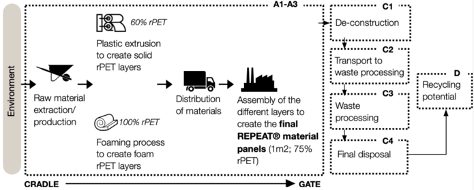Why plastic waste is an ideal building material
- lonneke50
- Jun 1, 2022
- 3 min read
The world’s plastic pollution crisis explained
Much of the planet is swimming in discarded plastic. However, the world produces still around 359 million tonnes of plastics each year. Of the plastic packaging, such as the plastic bottles you drink from, 95% is lost to the economy after a short first use, and take 450 years to decompose.
This has led to a stigma that plastics are an unsustainable material. And yes we still need to clean up the plastic waste. However, the main issue is not with plastic as a material, but with our linear economic model: Take-make-use-dispose. This model assumes endless economic growth and doesn’t consider the planet’s limited resources.
This is important because we could also set plastic in a circular pattern of "recycle-use-repeat". Turning disused plastics into a hardy, reliable and sustainable building material. This is important for to the construction industry, as plastic initiatives can replace conventional building materials. In this blog post, we will focus on recycled and recyclable plastic PET panel building material. We’ll define in this blog post (recycled and recyclable) PET building panels are and why they are good building materials, and show a few examples in which sectors the panels are and can be used in.

What are (recycled and recyclable) PET panels?
PET panels are plastic structural building panels that can be used for a wide range of needs by, among others, architects, interior designers, event stand builders, contractors, boat-, or campervan builders.
What is PET material?
PET (also abbreviated PETE) is short for polyethylene terephthalate, the chemical name for polyester. PET is a clear, strong, and lightweight plastic that is widely used for packaging foods and beverages, especially convenience-sized soft drinks, juices and water.
What is the difference between recycled PET and virgin PET?
Virgin PET plastic is a new direct resin produced using natural gas or crude oil and without any recycled materials. On the other hand, recycled PET plastic comes from products that were recycled after its life as a consumer product. For example your used PET drinking bottle, or recycled industrial waste, such as waste from cutting panels to size.
What is the difference between recycled and recyclable?
Recycled products are products made of ‘recycled content’. You have pre-consumer and post-consumer recycled products. Pre-consumer: Products made of industrial material waste generated by the manufacture. Post-consumer: Products made from used material waste collected from office/curbside recycling programs. A recyclable product means that the product can be collected and remanufactured into new products after they've been used.
How does PET recycling work?
The PET waste (from consumer and/or manufactures) generally goes to a materials recovery facility where it is separated from other recyclables and compressed into dense blocks or “bales” of PET containers for transport. Bales then go to a PET processor or “reclaimer” where the PET material is further sorted, ground into flake and washed. Depending on the intended end-use market, the clean PET flake will undergo various levels of additional processing to screen impurities, increase the rPET density and intrinsic viscosity (akin to “runny-ness,” or more scientifically, molecular weight), and/or improve the overall consistency of the recycled resin. Now the PET waste is made to clean rPET flakes, ready as a new resource to work with!
How are (recycled and recyclable) PET panels made?
Recycled and recyclable PET panels are made by laminating individual solid and foam layers of rPET into one sandwich panel.
The solid layers are created by the extrusion of the (recycled) PET flakes. Plastics extrusion is a high-volume manufacturing process in which raw plastic is melted and formed into a continuous profile, in this case (recycled) PET flakes into a solid layer profile.
The foam layers are created by the extrusion foaming of the (recycled) PET flakes. Extrusion foaming is the process in which a blowing agent is added to a molten polymer (in this case PET) and is decomposed to release gas. Then, the polymer is foamed by pressuring and heating creating a PET foam layer.
Those solid and foam layers of rPET are laminated into one rPET sandwich panel. Lamination is the technique/process of manufacturing a material in multiple layers, so that the composite material achieves improved strength, stability, sound insulation, appearance, or other properties. The products can be easily collected and remanufactured into new products after they've been used, because it only contain one material: PET. This is what makes the recycled PET panels also so easy to recycle.
What is the production proces of REPEAT® Materials panels?
REPEAT Materials® panels are the first structural recycled and recyclable PET panels that only contain PET (of which 75% recycled PET). See the figure below for our production process.

Why are recycled and recyclable PET panels a good building material?
When it comes to mechanical properties, ease of use and durability, recycled and recyclable PET panels can hold their own amongst the traditional competitors.
Plastics are strong, durable, waterproof, lightweight, easy to mould, and recyclable – all key properties for construction materials’, - stated scientific researcher Sibele Cestari in the BBC in August 2020.

Besides, state-of-the-art technology enables to make 100% recycled and recyclable top sheets from PET. The printing is done on a water base for a lower carbon footprint and gives the finishing available in a wide color and décor ranges. Thus, making it a highly recommended strong and aesthetic building panel by architects and interior designers.
Furthermore, the European Commission stated in a ‘Circular Economy Action Plan: For a cleaner and more competitive Europe’ in 2020 that: ‘Greater material efficiency at the design phase of products could save 80% of emissions’. The carbon footprint of recycled and recyclable PET panels shows a lower impact than competing products, such as HPL panels, aluminum composite panels and bio-composite sandwich panels. Scientific researcher Sibele Cestari states again why plastic waste (such as recycled and recyclable PET) is a good sustainable building material:
'Working with the ‘unrecyclable’ waste and developing plastics alternatives to natural materials may reduce demand on the world’s resources’, and 'Building with plastic waste requires fewer resources than natural products, and would otherwise go to landfill or into the oceans'.
Example applications of recycled and recyclable PET panels
Bathroom panels
Décor wall panels
Self-supporting walls
Panels for boat interior
Panels for camper-van interior
Event stands construction
Closing The Loop
It is time to change the linear economy to a more circular economy. Plastic waste shows to be an ideal building material.
For example, recycled and recyclable PET panels give architects and interior designers a strong, waterproof, lightweight building material to build with. The top sheets available in a wide color and décor ranges also enables them to build with eye for detail and give customers they style they prefer. On the other hand, those characteristics will also have a beneficial impact on the planet. The recycled and recyclable principles of the PET panels make the products a durable and sustainable building material. Reuse the same materials over and over again to create new products for purchase to conserve natural resources and divert plastic waste from the landfill.
Let’s close the loop. Let’s welcome plastic initiatives to replace conventional building materials.
REPEAT® Materials in your business

REPEAT® Materials is a leading innovator in the field of sustainable architectural materials, and a premier developer of high performance, low cost, and low environmental impact recycled and recyclable PET structural panels. Enthusiastic about recycled and recyclable PET panels after reading this blog post?

Comments